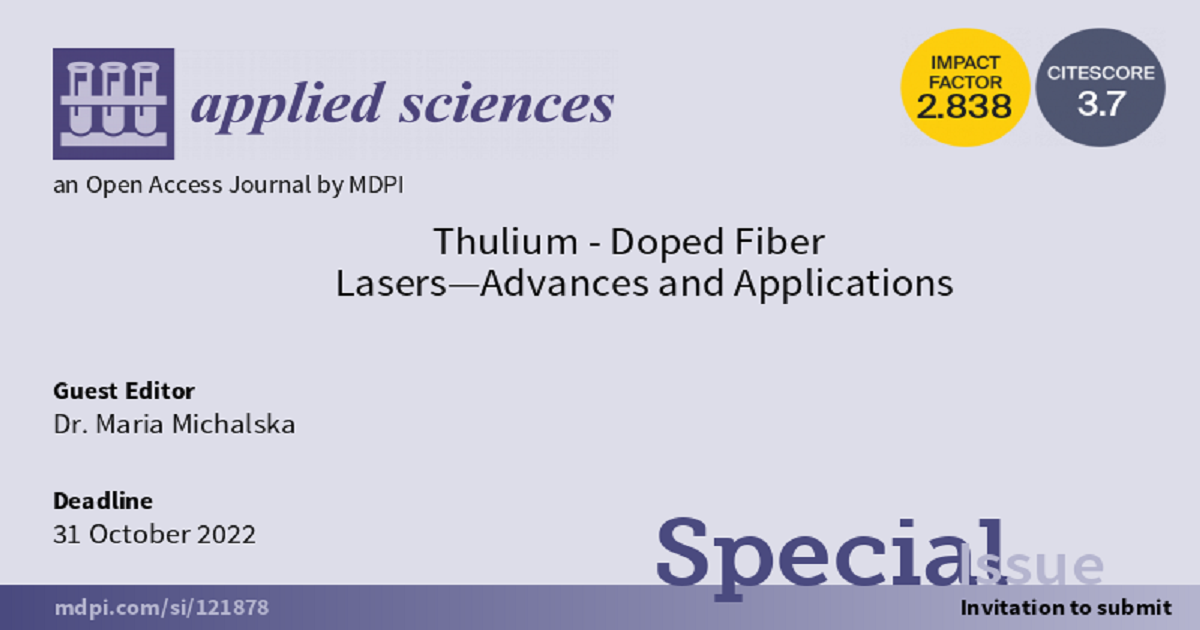Thulium-Doped Fiber Lasers—Advances and Applications
A special issue of Applied Sciences (ISSN 2076-3417). This special issue belongs to the section "Optics and Lasers".
Deadline for manuscript submissions: closed (31 October 2022) | Viewed by 15023

Special Issue Editor
Special Issue Information
Dear Colleagues,
We are inviting submissions to this Special Issue on “Thulium-Doped Fiber Lasers—Advances and Applications”.
Thulium-doped fiber lasers (TDFLs) have received great attention during recent decades, finding a wide spectrum of applications. In particular, the number of demonstrations of TDFLs generated at a wavelength range of 2 µm has increased rapidly in recent years. The gain bandwidth of Tm3+-doped silica fibers, ranging from 1.8 to 2.1 µm, makes TDFLs one of the most promising sources of mid-infrared coherent radiation for various applications, including medicine, spectroscopy, remote sensing, material processing, and frequency conversion. Due to the broadband gain bandwidth, thulium-doped fibers are also an excellent choice for an active medium in mode-locked fiber lasers and the generation of ultrashort pulses. Medical applications, especially soft-tissue surgery, can benefit from TDFLs operating at ~1.94 µm because of strong tissue absorption at this wavelength. The long-range propagation of laser radiation in the atmospheric transmission window around 2 µm can be address by using high-power, diode-pumped TDFLs. However, our topics of interest are not only limited to fiber lasers operating in the 2 µm spectral region, and reports on TDFLs utilizing other laser transitions are also invited.
This Special Issue of the Applied Sciences journal, “Thulium-Doped Fiber Lasers—Advances and Applications”, aims to present recent advances in the development of thulium-doped fiber lasers—different laser setups and generation regimes, including ultrafast mode-locked fiber lasers as well as high-power continuous-wave (CW) lasers, new designs of thulium-doped fibers, and their applications.
Dr. Maria Michalska
Guest Editor
Manuscript Submission Information
Manuscripts should be submitted online at www.mdpi.com by registering and logging in to this website. Once you are registered, click here to go to the submission form. Manuscripts can be submitted until the deadline. All submissions that pass pre-check are peer-reviewed. Accepted papers will be published continuously in the journal (as soon as accepted) and will be listed together on the special issue website. Research articles, review articles as well as short communications are invited. For planned papers, a title and short abstract (about 250 words) can be sent to the Editorial Office for assessment.
Submitted manuscripts should not have been published previously, nor be under consideration for publication elsewhere (except conference proceedings papers). All manuscripts are thoroughly refereed through a single-blind peer-review process. A guide for authors and other relevant information for submission of manuscripts is available on the Instructions for Authors page. Applied Sciences is an international peer-reviewed open access semimonthly journal published by MDPI.
Please visit the Instructions for Authors page before submitting a manuscript. The Article Processing Charge (APC) for publication in this open access journal is 2400 CHF (Swiss Francs). Submitted papers should be well formatted and use good English. Authors may use MDPI's English editing service prior to publication or during author revisions.
Keywords
- thulium-doped fiber
- fiber laser
- mode-locked fiber laser
- Q-switched fiber laser
- high-power fiber laser
- fiber laser application
Benefits of Publishing in a Special Issue
- Ease of navigation: Grouping papers by topic helps scholars navigate broad scope journals more efficiently.
- Greater discoverability: Special Issues support the reach and impact of scientific research. Articles in Special Issues are more discoverable and cited more frequently.
- Expansion of research network: Special Issues facilitate connections among authors, fostering scientific collaborations.
- External promotion: Articles in Special Issues are often promoted through the journal's social media, increasing their visibility.
- Reprint: MDPI Books provides the opportunity to republish successful Special Issues in book format, both online and in print.
Further information on MDPI's Special Issue policies can be found here.





